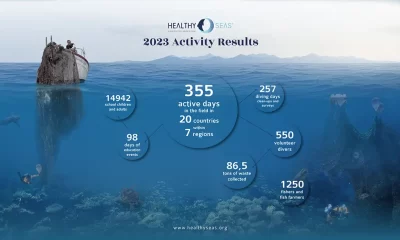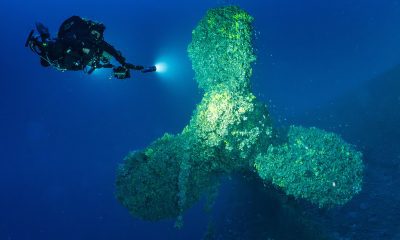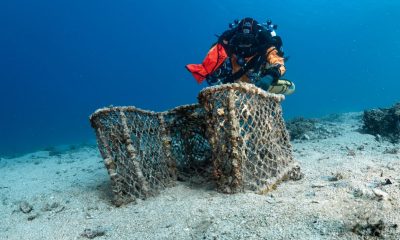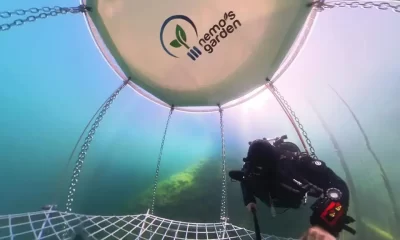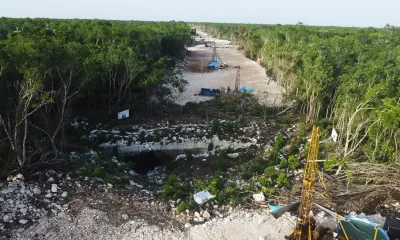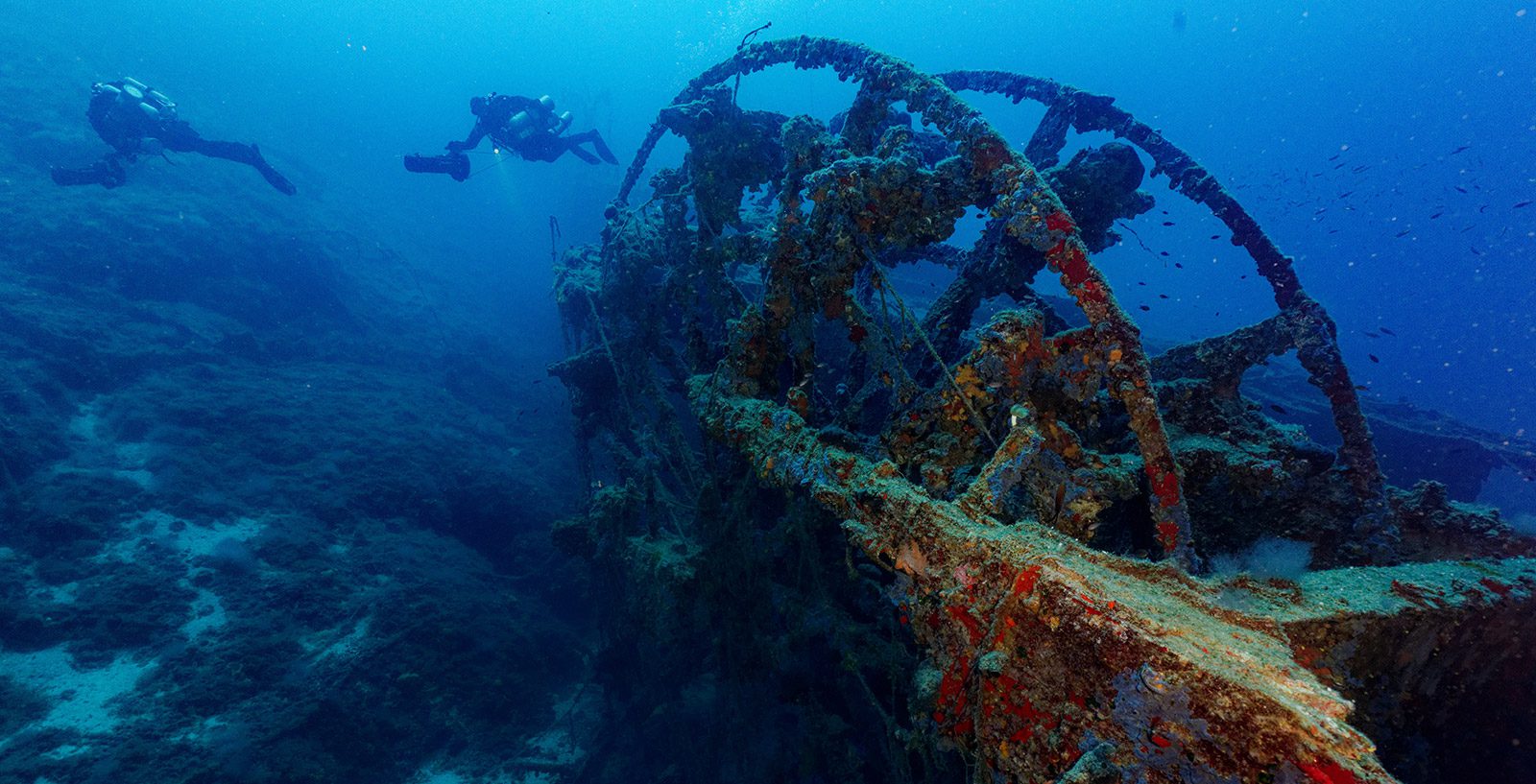
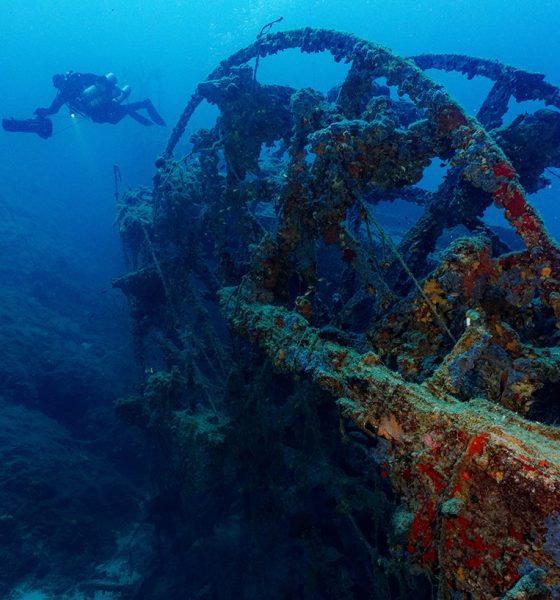
Conservation
Ghost Diving the Paddleship Patris
After providing background on the history and development of “ghost diving,” i.e., the removal of Abandoned, Lost, or otherwise Discarded Fishing Gear (ALDFG), Symeon Manias and Curtis Wolfslau, dive into the details of their operation to remove the netting from the paddleship steamer PSS Patris, which sank in 1868 and rests at a maximum depth of 56 m/185 ft. The team was able to remove more than 100 kg/220 lbs. of ghost netting.
By Symeon Manias and Curtis Wolfslau. Lead image: Divers surveying the wreck of the PATRIS.
The ocean, a vast and mysterious expanse, holds treasures, resources and undiscovered historic artifacts. However, it is also fragile and susceptible to various threats, including pollution, global warming, and habitat destruction. One of these threats is the presence of discarded fishing gear. To combat these challenges and protect marine ecosystems, teams of dedicated divers and marine environment enthusiasts around the world embark on critical missions. Their objective? To restore the sea’s balance and safeguard the delicate underwater realm by removing such discarded fishing gear.
The Wreck
The wreck of the paddle ship steamer PSS Patris holds a captivating tale that echoes through the passage of time. The steam engines moved the paddle wheels as the propeller had not yet been invented at that time. Although the first launch of paddle steamers dates back to 1800s, the developments sped up in the 1830s *
The PATRIS was the first steam engine paddle ship from the Hellenic Steamship Company with a length of 67 meters/220 feet, width of 8.5 meters/28 feet, weighing 708 metric tones/780 tonnes with 180 horsepower. It was born in 1860 at Deptford, England, at the Charles Langley shipyards and was originally named after the current King of Greece at the time, Othon. After being renamed to PATRIS it took commercial voyages from Piraeus to the islands of the Cyclades, including Syros, an important commercial and transit center of that era.
On February 23, 1868, while sailing its usual route from Piraeus to Syros with a few hundred passengers, it crashed when striking into Koundouros reef just off Kea island in Greece and sank. While sinking, it broke into two pieces. The main structure and the stern rests at 56 m/185 ft maximum depth while the bow sits at 34 m/110 ft. One of the paddle wheels has been removed and is now being exhibited at the Industrial Museum of Syros. At the time of construction, the metals used were rich in carbon and thus particularly hard, which contributed to the wreck being very well preserved, especially considering the time it has been underwater.
The first reference of divers visiting the wreck dates back to the 1970s by Theofilos Klimis and Lefteris Sarris. Rumors from an article by Roberto Datich in Diving Magazine led Vasilis Mentogiannis and Giorgos Nikolaidis to re-discover and identify the wreck in 2007. For a detailed story about the history and discovery of the wreck, the reader is referred to the documentary about the wreck which was awarded by the International Film and Video Festival, organized by The Archaeology Channel in 2010, in Eugene, Oregon, United States of America
Discarded Fishing Gear
Ghost gear, also known as Abandoned, Lost, or otherwise Discarded Fishing Gear (ALDFG), refers to the ongoing fishing activities of fishing equipment left in the ocean. When fishing equipment is lost at sea or discarded due to entanglement, it can trap, harm, and cause disturbances within delicate marine ecosystems. Reefs attract fish and other marine life as they can provide safety from larger predators. This marine life attracts fishermen, who can then lose or discard fishing gear which will continue to catch and kill fish until being removed by divers.
The original term was Ghost Fishing, but this was changed to Ghost Diving in 2020, to refer to removing ALDFG, remnants of fishing gear left behind or lost at sea. These remnants pose a great danger to marine life. They act as invisible death traps for countless marine creatures and lead to injury, suffocation, and death. They also contribute to the presence of micro plastics in the water, leaving an impact that will last for millennia . This gear remains active; it persistently traps, captures and ensnares marine animals, poses risks of entanglement and potential harm to marine life, obstructs habitats, and creates navigational hazards. Nets, traps, and pots are prominent examples of derelict fishing gear, constituting a significant form of debris that adversely affects the marine environment in present times.
Ghost gear not only ensnares fish but also poses a threat to sea turtles, dolphins, porpoises, birds, sharks, seals, and various other marine creatures, entangling them in its deadly grip. Removing such gear can be a challenging mission which would not be possible without the support of various organizations, government agencies, and fellow conservationists. Divers collaborate with researchers, marine biologists, and environmental groups to gather valuable data, conduct scientific studies, and implement effective conservation strategies. These partnerships strengthen the collective effort to protect the oceans and ensure a healthy marine environment for generations to come.
Our mission was sponsored by the non-government organization (NGO) Ghost Diving Greece and Healthy Seas. A plethora of organizations that help in removing and recycling ALDFG exist for example ghostdiving.org, healthyseas.org, oliveridleyproject.org, reefalert.org, ghostgear.org, just to name a few. Ghost Diving is twofold: on one hand it removes the discarded fishing gear from the ocean so that the “ghost fishing” is minimized. On the other hand, by cleaning discarded fishing gear, the beauty of historic wrecks such as the PSS PATRIS can be revealed and can be less hazardous to visit. The latest initiative of Ghost Diving Greece includes the Free The Wrecks campaign that aims to remove lost ghost fishing gear from historic wrecks in Greece.

Divers involved in these crucial missions recognize the importance of education and awareness in preserving marine ecosystems. They actively engage with local communities, sharing their experiences and insights about the state of the oceans. Through workshops, presentations, and outreach programs, they strive to inspire a sense of responsibility and ignite a passion for ocean conservation. By empowering individuals and communities, they lay the foundation for a sustainable future.
The divers’ mission goes beyond removing ghost nets. Armed with sturdy bags and specialised tools, they engage in thorough cleanup efforts. They collect and dispose of marine debris that pollutes the ocean, endangering marine life and ecosystems. Whether plastic bottles, discarded fishing lines, or fragments of human activity, these divers work tirelessly to restore the underwater habitat and historic wrecks to its natural splendor.
Equipped with technical scuba diving gear and unwavering determination, these courageous divers delve into the depths of the ocean. Their mission begins with extensive exploration and assessment of key underwater areas. They meticulously survey the seabed, reefs, and rocky formations, documenting the health of coral reefs, identifying areas affected by pollution, and spotting abandoned fishing gear known as ghost nets.
Divers adeptly navigate through coral reefs and rocky crevices, disentangling any unfortunate victims from the grip of these treacherous ghost nets. All ghost gear removed from the ocean is a step toward safeguarding marine biodiversity.
Divers who embark on these vital missions represent a small ray of hope for our oceans. Their unwavering commitment, bravery, and expertise play a pivotal role in restoring and preserving marine ecosystems. By removing ghost gear, cleaning up debris, educating communities, and fostering collaborations, these divers contribute significantly to the sustainability and well-being of our underwater world. Their efforts remind us of the urgent need to protect and cherish the magnificent beauty that lies beneath the ocean’s surface.
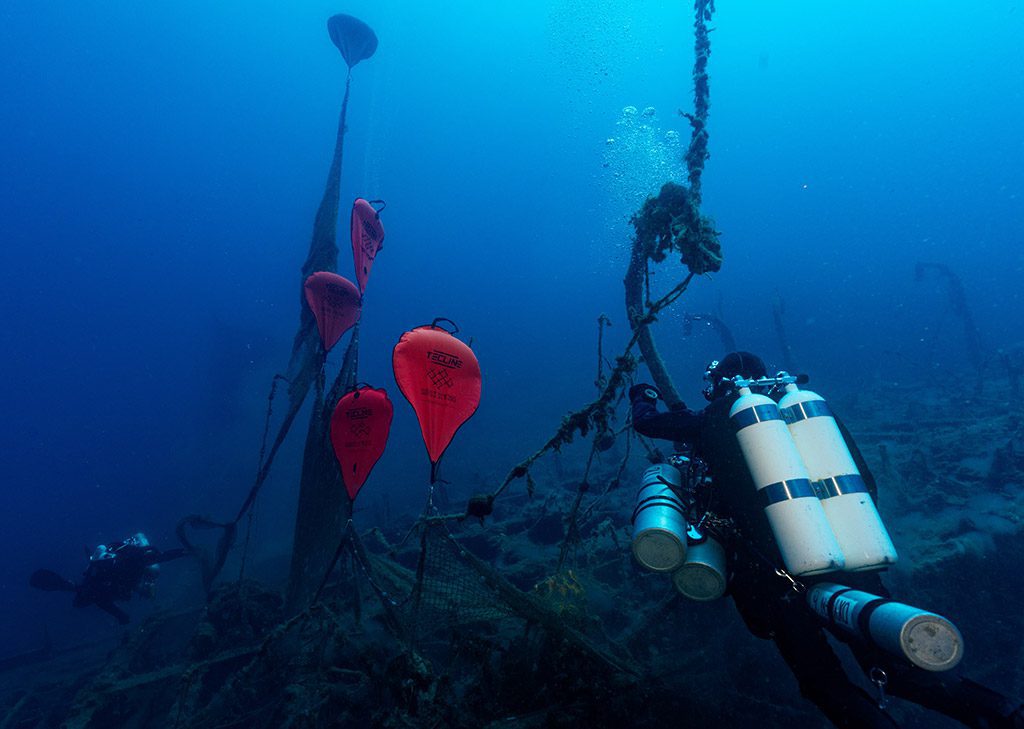
The Mission
Ghost gear removal always starts on land. In Greece, special permission is required by the Ephorate of Underwater Antiquities which is a Special Regional Service of the Hellenic Ministry of Culture and Sports, with jurisdiction all around Greece, aiming to protect and promote the Underwater Cultural Heritage.
Ghost Diving missions always begin with a thorough briefing. For this dive, two teams of divers were formed. The first team, all on scooters, consisted of Nikos Vardakas, Curtis Wolfslau, and Symeon Manias, carrying 16 lift bags and a camera setup to document the mission. Note that Symeon and Curtis are part of Ghost Diving USA. The second team consisted of Thanos Chondros, Nikos Kazantzakis and Merryn Wainwright who provided underwater support by meeting the first team partway through the mission, carrying additional lift bags, and supporting the first team on the shallower part of the wreck.
Team 1 was a mixed team of rebreather and open circuit divers all on GUE configuration. The dive plan was to use 60 minutes of bottom time at an average depth of 44 m/145 ft. This resulted in a reasonable 70 minutes of total decompression time using a 50/85 Gradient Factor and the ZHL16-B model. Our total dive time was 2 hours and 24 minutes.
Additional stage bottles were brought in order to inflate the lift bags. Nets are removed by attaching and inflating lift bags to key areas on the net. This lifts the net towards the surface. Unfortunately, most times the net is entangled and must be freed by the divers, who have to cut away the entangled portions of the net. When the net is finally freed, it rises to the surface to be collected by volunteers on the support boat.
The divers first descended to the deepest part of the wreck and placed eight lift bags. We spent 20 minutes inflating lift bags, cutting, and freeing the first deep net. We then progressed to the net in the middle of the vessel. We placed our next eight lift bags and spent 20 more minutes freeing this second set of nets. Once we placed all the 16 lift bags Team 1 was carrying, we moved to the shallower part of the wreck and picked up the additional lift bags from Team 2. We proceeded to work on the shallow net which was significantly entangled. We were running low on time and gas, so we decided to stop part of the way through this final net and begin our decompression. We will need to return to the site to finish the work we started.
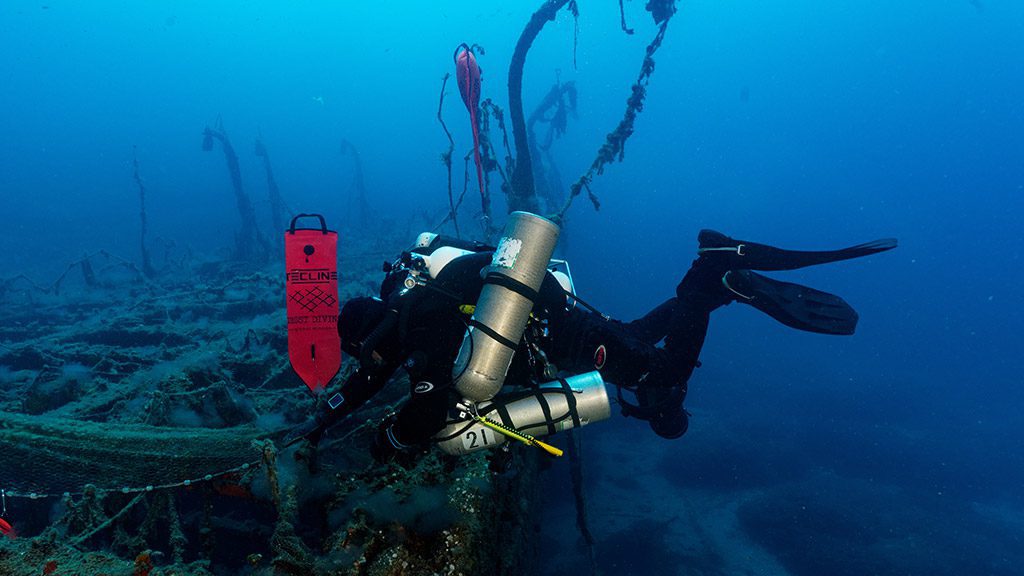
These missions would not be possible without the help of our surface support who collect the net as we lift and finish our decompression. By the time we surface, all the net has been collected, the marine animals freed, and the nets packed in bags. The volunteers also provide safety support for the divers and can assist in the event of a problem underwater.
Although the team did not completely remove all the ghost diving gear from the wreck, a good 100 kg of net is on the way to be recycled. We removed two types of nets: a set of trawler nets from the deeper part of the wreck, where they were heavily entangled, and a set of trammel nets.
Healthy Seas ensures that the recovered nets are given new life through a circular economy. After transporting, sorting, and cleaning the nets, those suitable for recycling (the undamaged ones made of Nylon 6) are sent to Aquafil where they are mixed together with nets from aquaculture and other materials. This waste is regenerated into brand new ECONYL®️, a high-quality raw material used to create new products, such as socks, swimwear, sportswear or carpets, while other types of plastic nets are also reused, becoming jewelry, accessories, or repurposed for research and education purposes.
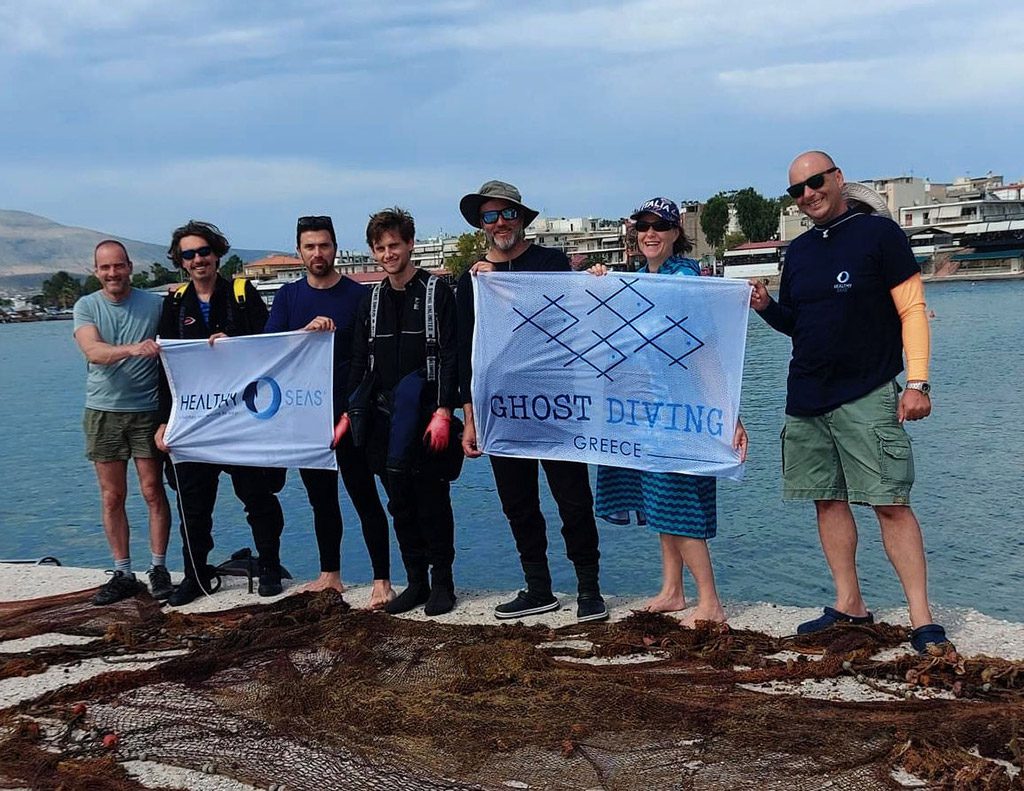
The Surface Support Team: Antonis Grafas, Dimitris Konstantinou, Jenny Ioannou Support/Logistics: Scuba Life.
DIVE DEEPER
YouTube: Paddleship Patris (2010)
InDEPTH: International Marine Conservation Organisations Return to Greece to Tackle Ghost Farms (July 2022)
InDEPTH: Ghost Fishing UK land the prize catch at the Fishing News Awards (June 2022)
InDEPTH: Resurrecting a Ghost: The Launch of Ghost Diving USA By Katie McWilliams. (May 2022)
InDEPTH: Why We Ghost Dive by Rob Wilson (April 2022)
InDEPTH: Ghost Fishing changes its name to Ghost Diving to focus on the solution (March 2020)
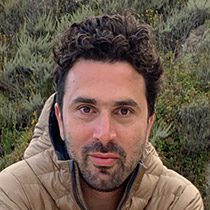
Symeon Manias is a passionate adventurer and lover of the underwater world. He was born and raised in a coastal town and developed a deep fascination for the mysteries hidden beneath the waves from an early age. Although he pursued a different career in his adult life, his heart always belonged to explore the vast expanse of the ocean. Symeon sees each dive as an opportunity to connect to the underwater world and raise awareness about their fragile nature. Outside the water, he channels his passion into promoting underwater exploration and marine conservation. Through his photography, he captures the beauty of the underwater world, sharing his experiences and inspiring others to protect and appreciate marine life.
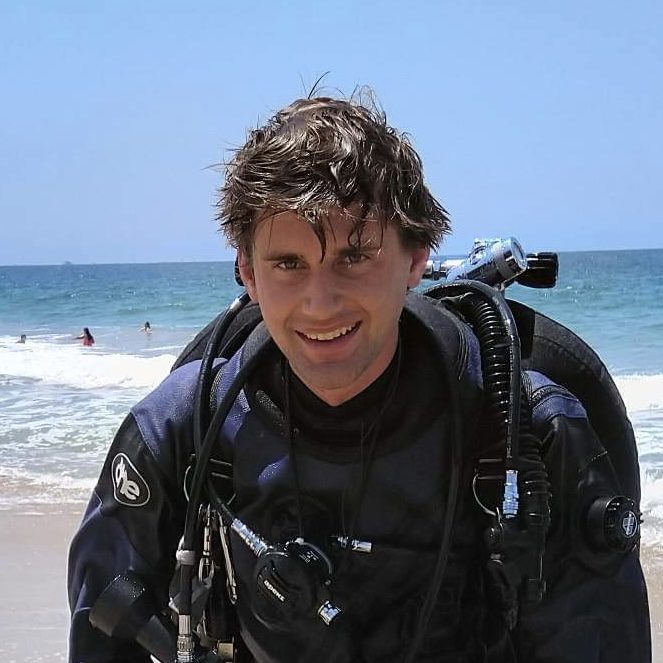
Curtis Wolfslau is an avid diver whose passions include exploring and conserving shipwrecks. He volunteers with Ghost Diving USA, a non profit dedicated to removing abandoned fishing gear from our oceans. Curtis grew up exploring and diving the Southern California Channel Islands and enjoys sharing the fragile beauty of the underwater world through his photography.




















